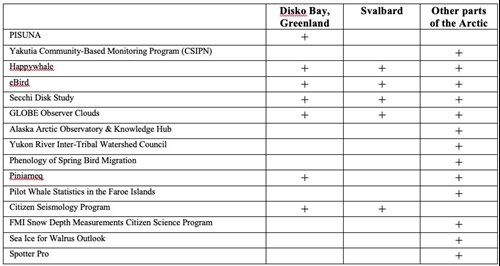CBM can build local relations that stimulate dynamic and adaptive resource management.
Challenges:
Community-based monitoring (CBM) and citizen science are approaches whereby indigenous and local communities are directly involved in data collection and sometimes data interpretation. There are over one million indigenous and local residents in the Arctic, which represent a large group of people who can contribute to environmental and climate data collection. Citizen science is closely connected to community-based monitoring, but the former is more science-driven while the latter is community-driven and often linked to the decisions of local stakeholders, using methods that are simple, cheap and require few resources. Community-based monitoring can build relations between local stakeholders and the authorities, thereby stimulating local action and resulting in dynamic and adaptive resource management. There are several challenges at the social, technological and resourcing level that need to be addressed if community-based monitoring is to play a bigger role in informing decision-making in the Arctic.
Results from INTAROS:
CBM and citizen science work has been supported in Greenland, Svalbard, Yakutia and Alaska. In northwest Greenland community-based observations of natural resources have been developed where typically fishermen and hunters make routinely observations. The observations document the living resources, promote local discussion, and shorten the time from observation to decision. The data are registered in the Greenland Government’s community observing network PISUNA, as shown in the figures below.

Figure 1: Left: The communities involved in the resource observations in Northwest Greenland. Centre: Registration of local resources in Disko Bay (Photo : F. Danielsen). Right: Overview of data from 357 monthly reports on resource observations.
An example of a citizen science activity initiated by INTAROS is to install small low-cost, automatic seismometers which register earthquakes and transmits data to a global network provided that there is internet access. One such seismometer was installed on the bedrock under the house of fisherman Gerth Olsen (See figures below). Data from the seismometer enabled the location of 23 seismic events and improved the location of 209 events, significantly enhancing our understanding of both ice-generated and tectonic events in the area. Citizen seismology is useful where buildings are constructed on bedrock and trusted relationships exist between government agencies, scientists and residents. It may help build community awareness of natural hazards.

Figure 2: Left: Gerth Olsen, Akunnaaq, with seismograph before connecting it to electricity and a router and placing it on the rock below his house. Photo: F. Danielsen. Center: Raspberryshake seismometer. Right: A seismogram showing the recording of a magnitude 2.0 earthquake located 122 km South-West of Akunnaaq, May 21st 2018.
In Sakha Republic, Yakutia, we have assisted community organizations to establish CBM programmes. A number of groups of reindeer herders, fishermen and hunters are monitoring the environment and the mining that is being undertaken or planned on their traditional territories. The CBM program are organsed under the Centre for Support of Indigenous Peoples of the North (CSIPN) which is a non-governmental organisation that works to protect the rights of the indigenous peoples of Siberia and the Russian North and Far East. The CBM programs enables dialogue between the extractive industries and the owners and users of the traditional lands (LINK). As an example, a community in Zhigansk District obtained the rights to a traditional fishing ground in part because of its active participation in the CBM.
A number of CBM and citizen science projects have been assessed and their data have been registered in the INTAROS data catalogue, as shown in the table below. For each program the catalogue contains title, name of organizer(s) if different from program, introduction to the program, key-words listed as “tags”, attributes listed as “parameter name(s)”, and links to data collection or information on how to get access to data collection. Typical "parameter names" are wildlife, fisheries, pasture quality, reindeer, predators, climate, environmental changes, snow, ice, pollution, visitors, abundance.
Table 1: Community-Based Monitoring and Citizen Science data collections in the INTAROS Data Catalogue.

12-10-2021
